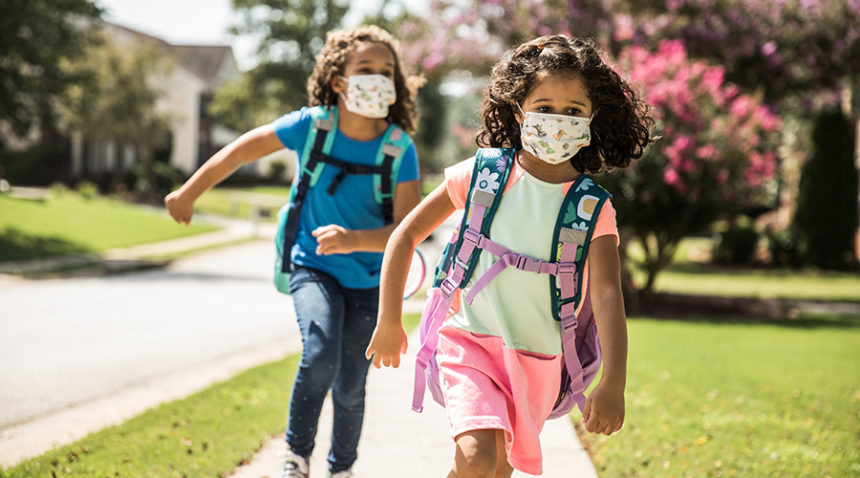More than 50 million children will head back to the classroom this fall—some for the first time in more than a year. With the much more contagious delta variant of the COVID-19 virus wreaking havoc across the country, many parents are worried about whether it’s even safe to go back to school.
But experts say it’s critically important that children attend school in person for their academic and social development. And millions of American children rely on school for free or reduced-price meals, internet access, mental health support and vital services such as physical, occupational and speech therapy.
“Our whole lives are balancing risks and benefits, so if you want to send your children to school because of the benefits of school, then there are definitely ways that the kids can be safe even in the midst of the pandemic,” says UNC Health family medicine physician Sarah Ruff, MD.
Here are four ways you can keep your child as healthy as possible this school year.
1. Make sure your child wears a mask at school.
Masks not only protect you from getting sick, but they also help you keep your germs to yourself and minimize the volume of airborne droplets that can spread viruses. But not all masks are the same. Make sure your child’s mask is snug, minimizing gaps around the nose, cheeks and chin. Improving the fit has been shown to increase a mask’s effectiveness by up to 20 percent.
Remind your child not to touch the outside of the mask, which could have virus particles on it. Teach your child to take off the mask and put it on by touching only the ties or elastic that goes around the ears.
Have extra masks on hand in case one gets lost or dirty. Ideally, you should have enough masks that you can wash them after every use. If you have only one, be sure to wash it a few times a week.
Also, safely store masks in a clean place, such as a zip-close or paper bag—don’t let your child just throw them in the bottom of a backpack or gym locker.
Finally, remind your child to wash his or hands regularly, especially when handling a mask.
2. Stay up to date on vaccinations.
Everyone in your household older than 12 should get the COVID-19 vaccines.
“One of the main ways you can keep the kids safe is for all the adults in their lives to be vaccinated against COVID-19, even if the kids can’t be vaccinated themselves. Everybody who can get it should, because if there’s less community spread, then there’s less chance that the kids are going to get sick,” Dr. Ruff says. “If you have a 12-and-up kid, get them vaccinated. It’s safe.”
Also, make sure your child is up to date on any other required shots. In addition to the vaccines most children receive before they even start preschool, school-age children need shots for Tdap, meningitis and HPV.
3. Do not send your child to school if he or she is sick.
Just because your child is under the weather doesn’t mean he or she has COVID-19. It could be allergies, a cold, the flu or a range of other common childhood illnesses, such as strep throat or a stomach bug.
“If you think your child might be sick, whether it’s a cold, flu, COVID or something else, stay home,” Dr. Ruff says.
If your child has a highly contagious illness, such as COVID-19, pinkeye or RSV, be sure to tell his or her teacher so extra steps can be taken to sanitize the classroom.
“You’re always most contagious before you actually come down with the symptoms,” Dr. Ruff says.
4. Remind children not to share food—especially if they have food allergies.
Not only does sharing food increase the risk of spreading germs and illnesses, but it also poses a risk to the nearly 10 percent of school-age children who have life-threatening food allergies.
“While COVID is front and center in the minds of parents as they prepare for back-to-school, there are also unique considerations for food-allergic kids and their families,” says Edwin Kim, MD, director of the UNC Food Allergy Initiative and a parent of two children with food allergies.
For parents like him, the fear that one wrong bite could result in a severe allergic reaction is a constant worry. Dr. Kim notes, for example, that free lunch programs often don’t have many allergen-free options, posing a risk if kids were to trade food.
“The focus on distancing during meals and even eating lunch outdoors may make it harder for teachers to oversee young children and prevent them from sharing food,” Dr. Kim says. “The most important and effective thing that we can do to prevent food allergic reactions at school is to teach our kids to control what goes in their mouth and not share food.”
Is your child not feeling well? Talk to your doctor or find one near you.

